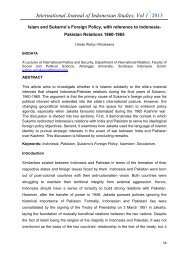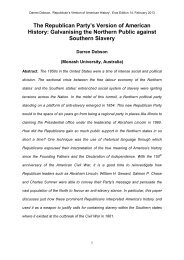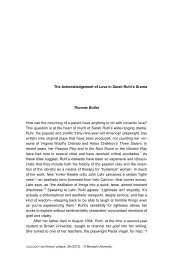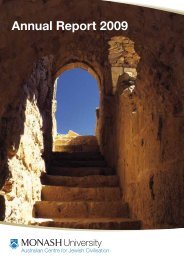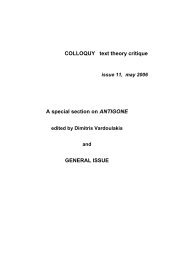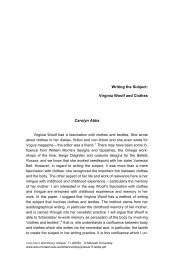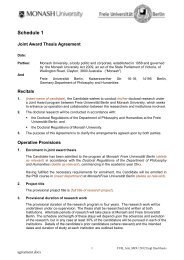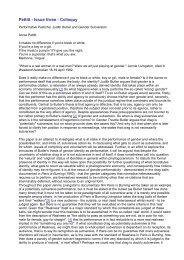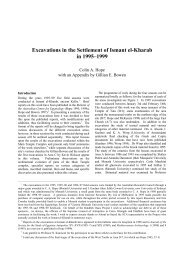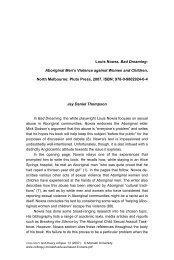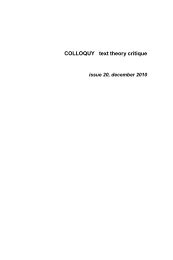Narratives and the gift of the future Corinne Squire Abstract In ... - Arts
Narratives and the gift of the future Corinne Squire Abstract In ... - Arts
Narratives and the gift of the future Corinne Squire Abstract In ... - Arts
You also want an ePaper? Increase the reach of your titles
YUMPU automatically turns print PDFs into web optimized ePapers that Google loves.
<strong>Narratives</strong> <strong>and</strong> <strong>the</strong> <strong>gift</strong> <strong>of</strong> <strong>the</strong> <strong>future</strong><strong>Corinne</strong> <strong>Squire</strong><strong>Abstract</strong><strong>In</strong> this paper, I address <strong>the</strong> assumption that narratives work normatively, <strong>and</strong> argue thatinstead that narratives are as important for registering particularities <strong>and</strong> differences thatevade normalisation. Such singularities can be understood as moral appeals from <strong>the</strong> <strong>future</strong>. Idraw on notions <strong>of</strong> deconstruction as a <strong>future</strong>-<strong>and</strong> ethics-oriented technology, to suggest thatnarratives can work similarly, <strong>and</strong> I give some examples from my own recent study <strong>of</strong> visualautobiographies.
<strong>Narratives</strong> <strong>and</strong> <strong>the</strong> <strong>gift</strong> <strong>of</strong> <strong>the</strong> <strong>future</strong><strong>Corinne</strong> <strong>Squire</strong><strong>In</strong>troduction<strong>In</strong> this paper, I engage with <strong>the</strong> common assumption that narratives work progressively, toimprove <strong>and</strong> adapt (Plummer, 2001), or conservatively, to consolidate, maintain or at timesevade (Mac<strong>In</strong>tyre, 1984; Frosh, 2002), but in any case in a normative way. <strong>In</strong> addition, Iargue that at <strong>the</strong> same time, narratives do something as or more important. Through <strong>the</strong>possibilities <strong>of</strong> movement towards <strong>the</strong> <strong>future</strong>, in <strong>the</strong> sense <strong>of</strong> an opening <strong>of</strong> a new context,<strong>the</strong>y register <strong>the</strong> particularity <strong>of</strong> difference, dissidence, <strong>and</strong> <strong>the</strong> hard-to-underst<strong>and</strong>. Suchnarrative appeals from elsewhere, <strong>and</strong> from o<strong>the</strong>rs, are not merely disruptive or fragmenting;<strong>the</strong>y can be understood as moral appeals from <strong>the</strong> <strong>future</strong>.I make this argument by drawing on some <strong>of</strong> my research on visual autobiographies,conducted with Cigdem Esin <strong>and</strong> Chila Burman, <strong>and</strong> a group <strong>of</strong> adults <strong>and</strong> young people, <strong>of</strong>varying socioeconomic <strong>and</strong> cultural backgrounds, in East London: an emblematicallysocioeconomically <strong>and</strong> culturally diverse area <strong>of</strong> a world city (Massey, 2007). This workdefined autobiographical images, interviews <strong>and</strong> o<strong>the</strong>r talk <strong>and</strong> writing about <strong>the</strong> images, <strong>and</strong><strong>the</strong> activities <strong>of</strong> making, commenting on <strong>and</strong> exhibiting <strong>the</strong> images, as all forms <strong>of</strong> narrative.That is, <strong>the</strong> signs that constituted <strong>the</strong>m moved, or changed, within each medium, <strong>and</strong> alsobetween <strong>the</strong> media, in ways that built socioculturally recognisable meanings; <strong>and</strong> <strong>the</strong>semeanings were particular, ra<strong>the</strong>r than general, as one would find within a <strong>the</strong>ory (<strong>Squire</strong>,2012; Esin <strong>and</strong> <strong>Squire</strong>, forthcoming). This research project gave rise to some very open <strong>and</strong>contextually responsive forms <strong>of</strong> narrative, which are particularly salient for <strong>the</strong> <strong>the</strong>oreticalframework I am discussing.Narrative’s prominence in social science academic <strong>and</strong> applied research has led to someidealisation <strong>of</strong> stories as in <strong>the</strong>mselves progressive <strong>and</strong> a ‘good thing’, <strong>and</strong> sometimes ascapable <strong>of</strong> solving problems not obviously confined to <strong>the</strong> realms <strong>of</strong> representation(Riessman, 2008). The opposing argument s that a reliance on personal narratives, whe<strong>the</strong>rthose narratives seem ‘progressive’ or not, is problematic, because narratives are not aprivileged source <strong>of</strong> knowledge, <strong>and</strong> may indeed be inherently rigid, reifying <strong>and</strong> monolithic.Atkinson (1997, 2009) suggests that social researchers have romanticised narrative ‘voice’ at<strong>the</strong> expense <strong>of</strong> narrative analysis, particularly in <strong>the</strong> area <strong>of</strong> health <strong>and</strong> illness, where storieshave become elided with critiques <strong>of</strong> medicalisation <strong>and</strong> patient empowerment. Craib (2004)suggested that narratives’ simplifications <strong>and</strong> superficiality can be forms <strong>of</strong> ‘bad faith, ’ bothin intellectual explanations <strong>and</strong> motional workings-through. Frosh points to <strong>the</strong> necessaryrepetitions <strong>and</strong> closure within conventional narratives, with <strong>the</strong>ir beginnings, middles <strong>and</strong>
ends, as working against psychoanalytic deconstruction <strong>and</strong> fixing <strong>the</strong> self - <strong>and</strong> yet also as acanonic structure, at least in <strong>the</strong> west, that has to be worked with, <strong>and</strong> that is part <strong>of</strong> anemancipatory <strong>and</strong> activist agenda (2010: 115, 198).There is however, a great deal <strong>of</strong> narrative research that already tries to take into account<strong>the</strong>se undoubtedly valuable criticism. Riessman’s (2008) <strong>and</strong> Andrews’s (2008) work focuseson <strong>the</strong> always recontextualised, reread nature <strong>of</strong> narrative meaning. Freeman (2006)articulates <strong>the</strong> regions <strong>and</strong> multiplicities,ra<strong>the</strong>r than <strong>the</strong> unity, <strong>of</strong> narrative truth. Hyvarinen<strong>and</strong> cowriters (2010) syn<strong>the</strong>sise a growing body <strong>of</strong> work focused on incoherence ra<strong>the</strong>r thancoherence as narrative’s most interesting feature. <strong>In</strong> my own research, I have tried toarticulate <strong>the</strong> openness <strong>and</strong> flux that characterise narrative genres (2007). Such work paysattention to <strong>the</strong> opening-up, multiplicative effects <strong>of</strong> ‘context’ - interpersonal, social <strong>and</strong>cultural milieux - on narrative meanings. Here, however, I am going to define ‘context’ morebroadly, to take in <strong>the</strong> wider matrix <strong>of</strong> narratives - non-linguistic elements <strong>of</strong> signification,<strong>the</strong> bodies <strong>of</strong> storytellers <strong>and</strong> audiences, <strong>the</strong> physical environment, historical memory,economic determinants <strong>and</strong> political contests. <strong>In</strong> addition, I am going to explore some lessconsideredaspects <strong>of</strong> context: its disruptive <strong>and</strong> productive effects on narrative’s relation to<strong>the</strong> <strong>future</strong>, <strong>and</strong> to responsibility.<strong>Narratives</strong>, <strong>future</strong>s, responsibilities, selvesMy <strong>the</strong>oretical framework for this paper proposes that underst<strong>and</strong>ing narratives as embeddedin changing contexts is also a way <strong>of</strong> conceptualising <strong>the</strong>ir placement in relation to <strong>the</strong> <strong>future</strong>–<strong>and</strong> in relation to a responsibility that calls subjects <strong>the</strong>mselves into being. This relationbetween context, <strong>future</strong>, responsibility <strong>and</strong> selves in language, including narrative language,can usefully be understood through <strong>the</strong> work <strong>of</strong> Jacques Derrida, Drucilla Cornell <strong>and</strong> JudithButler.The title <strong>of</strong> this paper is adapted from a piece that <strong>the</strong> philosopher Drucilla Cornell wrote
after Derrida’s death for <strong>the</strong> journal Differences, ‘Derrida: The <strong>gift</strong> <strong>of</strong> <strong>the</strong> <strong>future</strong>’ (2005), i inwhich Cornell draws out Derrida’s ra<strong>the</strong>r specific notion <strong>of</strong> <strong>the</strong> <strong>future</strong>, as what she calls an‘o<strong>the</strong>r already with us’ - not a horizon or a teleology, but a singularity that calls to us <strong>and</strong>dem<strong>and</strong>s something from us (Derrida, 2001: 20-1). This <strong>future</strong> does have something to dowith time – but as elsewhere in Derrida’s work, it is not about linear temporal progression,but about interruptions - an intrusion <strong>of</strong> <strong>the</strong> past into <strong>the</strong> present; <strong>the</strong> overdetermination <strong>of</strong><strong>the</strong> <strong>future</strong> by a <strong>future</strong> already lived through; a retrospective resignification <strong>of</strong> past events(Cornell, 1992). This <strong>future</strong> as interruption or break positions us as responsible, <strong>and</strong> asneeding to attend to <strong>the</strong> requirements <strong>of</strong> justice. Its call is also a <strong>gift</strong>, always opening up <strong>the</strong>possibility <strong>of</strong> a new context; in responding to that call, <strong>the</strong>refore, we are always on <strong>the</strong> move,always living <strong>and</strong> making a story.<strong>Narratives</strong> are frequently understood as morality tales –usually, as means <strong>of</strong> transmitting pastmoralities (Mac<strong>In</strong>tyre, 1984). What this paper suggests, drawing on Derrida’s idea <strong>of</strong> <strong>the</strong><strong>future</strong>, is that a singularity or exceptionality that calls for something different, morally, that is,in terms <strong>of</strong> <strong>the</strong> narrator’s responsibility, is always getting expressed within narratives – forinstance, through those constitutive incoherences that Hyvarinen <strong>and</strong> colleagues (2010) note,or through exceptional moments (<strong>Squire</strong>, 2012) - at <strong>the</strong> same time as narratives sediment <strong>and</strong>reproduce <strong>the</strong>mselves. This dualism is something like that described in Ricoeur’s (1991)work on narrative as simultaneously embodying <strong>and</strong> shifting traditions. Here, however, weare talking about a dualism that is not dialogue or coexistence, but contest; aboutexceptionality as constitutive <strong>of</strong>, <strong>and</strong> not remediable within, narratives; <strong>and</strong> about disruptionsthat can be very ambiguous <strong>and</strong> subtle.This subtlety lies in <strong>the</strong> nature <strong>of</strong> <strong>the</strong> <strong>gift</strong> (Derrida, 1995). A <strong>gift</strong> is inevitably compromised:
any response that recognises it, also traduces its intransitive nature, turning it into somethingelse, something reciprocal; but such a response is also inevitable; it what makes <strong>the</strong> <strong>gift</strong> whatit is. The call <strong>of</strong> <strong>the</strong> <strong>future</strong>, <strong>the</strong> ‘o<strong>the</strong>r already with us’, is similarly ambiguous. It happensrepeatedly, infinitely, <strong>and</strong> <strong>the</strong> outcome is not fixed in any way. A <strong>gift</strong> does not predetermineany response or return, but it does make an open appeal to us as some kind <strong>of</strong> recipient, evenif we choose not to answer, we answer insufficiently, or we answer from <strong>the</strong> position <strong>of</strong> asubjecthood that we can never fully assume. The responses we make in <strong>and</strong> throughnarratives to <strong>the</strong> <strong>gift</strong> <strong>of</strong> <strong>the</strong> <strong>future</strong> are not, though, r<strong>and</strong>om or relativistic; <strong>the</strong>y occur inspecific contexts, <strong>and</strong> <strong>the</strong>y matter to us.The impossible yet necessary nature <strong>of</strong> such personal responsibility is important for us torecognise when analysing narratives. Judith Butler in Giving an account <strong>of</strong> oneselfemphasises how this requirement ties subjects, even though <strong>the</strong>y are fundamentallyunknowable to <strong>the</strong>mselves, to o<strong>the</strong>rs:If <strong>the</strong> subject is opaque to itself, not fully translucent <strong>and</strong> knowable to itself, it is not<strong>the</strong>reby licensed to do what it wants or to ignore its obligations to o<strong>the</strong>rs (2005: 19-20)And this insistence <strong>of</strong> responsibility comes about because <strong>of</strong> <strong>the</strong> repeated appeals <strong>of</strong> singular‘<strong>future</strong>s’. As Cornell puts it:The mark we leave on <strong>the</strong> world we share will be inseparable from those infiniteappeals made to us <strong>and</strong> how we responded when we were called’ (2005: 69).
To explain <strong>the</strong>se always-renewed calls, Cornell quotes an explanation from Derrida’s (2001)A taste for <strong>the</strong> secret, where <strong>the</strong> appeal <strong>of</strong> <strong>the</strong> <strong>future</strong> is given a language-based exegesis thatmakes its significance clear for narrative work:A simple phrase takes its meaning from a given context, <strong>and</strong> already makes its appealto ano<strong>the</strong>r one in which it will be understood; but, <strong>of</strong> course, to be understood it has totransform <strong>the</strong> context in which it is inscribed. As a result, this appeal, this promise <strong>of</strong><strong>the</strong> <strong>future</strong>, will necessarily open up <strong>the</strong> production <strong>of</strong> a new context, wherever it mayhappen. The <strong>future</strong> is not present, but <strong>the</strong>re is an opening onto it; <strong>and</strong> because <strong>the</strong>re isa <strong>future</strong>, a context is always open. What we call opening <strong>of</strong> <strong>the</strong> context is ano<strong>the</strong>rname for what is still to come (2001: 19-20)We can extend this argument: what happens with ‘a simple phrase’ also happens at a smallercontextual scale - from phoneme to phoneme, gesture to gesture – <strong>and</strong> at larger scales, within<strong>and</strong> across narratives. <strong>Narratives</strong> take meaning from particular contexts while beingunderstood within different ones. These hermeneutic processes transform <strong>the</strong> narrative‘context’ ready for <strong>the</strong> next attempt at underst<strong>and</strong>ing (Medved <strong>and</strong> Brockmeier, 2010). At <strong>the</strong>same time, this movement towards <strong>the</strong> <strong>future</strong> is enacted within narratives, because <strong>the</strong>y are<strong>the</strong>mselves characterised by what, at <strong>the</strong> most minimal, we can call some kind <strong>of</strong> movementor change – temporal, <strong>the</strong>matic, causal, spatial, syntactic, or tonal. A narrative inherentlyconstitutes an appeal to its own <strong>future</strong> as something different. So it is doubly – at least - ‘on<strong>the</strong> move’.The issue <strong>of</strong> <strong>the</strong> <strong>future</strong> – <strong>and</strong> different ways <strong>of</strong> underst<strong>and</strong>ing it - is particularly important fornarrative work because, despite <strong>the</strong> diversity <strong>of</strong> definitions, narrative is frequently <strong>and</strong>
hegemonically conceptualised in relation to linear time, as ra<strong>the</strong>r straightforwardly ‘on <strong>the</strong>move’ towards ‘<strong>the</strong> <strong>future</strong>’, albeit with many complications <strong>and</strong> circlings-about along <strong>the</strong>way. This is particularly true within social research; work within <strong>the</strong> humanities has taken amore complicated approach to how narratives are ‘on <strong>the</strong> move. For instance, Jean- FrancoisLyotard’s (1991) emphasis on <strong>the</strong> question, ‘is it happening?’ (arrive-t-il?), a question that<strong>the</strong> closed ‘gr<strong>and</strong>’ narratives <strong>of</strong> modernity do not ask, is also for him an ethical imperative, aquestion about <strong>the</strong> link between one thing <strong>and</strong> <strong>the</strong> next that recognises <strong>the</strong> ‘nothing’ between<strong>the</strong>m, that requires a radical receptivity <strong>and</strong> responsibility to incomprehensible events <strong>and</strong>that puts <strong>the</strong> <strong>future</strong> in question at every instant. My approach differs from Lyotard’s becauseit does not focus only on ‘forward’ motion. It is interested inwhat Derrida <strong>of</strong>ten called‘nostalgia’, an opening <strong>of</strong> <strong>the</strong> <strong>future</strong> through <strong>the</strong> past, death*, <strong>and</strong> it charts disruptions that arenot just events. Jasmina Sermijn, Patrick Devieger <strong>and</strong> Gerrit Loots (2008) draw on GillesDeleuze <strong>and</strong> Felix Guattari’s idea <strong>of</strong> ‘<strong>future</strong>s’ by presenting ano<strong>the</strong>r alternative, a rhizomaticway <strong>of</strong> underst<strong>and</strong>ing narrative movement according to which one can enter into <strong>the</strong> narrativenetwork anywhere <strong>and</strong> be immediately fully connected. The approach that I am advocating,however, is more tied to <strong>the</strong> particularities <strong>of</strong> histories <strong>and</strong> social formations, more committedto <strong>the</strong> discontinuities between <strong>the</strong> present moment <strong>of</strong> a narrative, <strong>and</strong> its <strong>future</strong>s – <strong>and</strong> indeedpasts – than this Deleuzian work. Narrative moment for me is, as in Derrida’s work, lessmobile, more entangled. It is always complicated by traces – <strong>the</strong> unpredictabilities <strong>of</strong> postaldelivery; <strong>the</strong> delay on <strong>the</strong> line between voices talking; <strong>the</strong> letters already etched on <strong>the</strong>typewriter ribbon; <strong>the</strong> prior documents or lines <strong>of</strong> machine code that sometimes flash up on acomputer; <strong>the</strong> undecideability <strong>of</strong> what someone says, or writes - that hang in <strong>the</strong> air or blur<strong>the</strong> text.
Within this perspective, narratives do not just transmit, but create. We are used to hearing thatnarratives –among o<strong>the</strong>r functions - transmit <strong>and</strong> inculcate moralities. This has beenrepeatedly claimed by psychologists such as Jerome Bruner <strong>and</strong> by some philosophers,notably Alastair Mac<strong>In</strong>tyre. The work <strong>of</strong> Derrida, Cornell <strong>and</strong> Butler suggests also thatnarratives respond afresh to <strong>the</strong> implicit ethical calls from o<strong>the</strong>r contexts, o<strong>the</strong>r <strong>future</strong>s, thatrepeatedly disturb <strong>the</strong>m. Moreover, in this work, , <strong>the</strong> multiple <strong>future</strong>s necessarily notresponded to, <strong>the</strong> narratives not articulated, <strong>and</strong> <strong>the</strong> inevitably to some extent totalising,violent effects <strong>of</strong> <strong>the</strong> narratives produced, are also part <strong>of</strong> <strong>the</strong> ‘story,’ <strong>the</strong> movement.Ethics involves choices that compromise ethics: ‘I am responsible to any one...only by failingin my responsibility to all <strong>the</strong> o<strong>the</strong>rs’ (Derrida, 1995: 70; see also1985). We are all aware <strong>of</strong>stories not told when we tell a certain tale, <strong>and</strong> <strong>of</strong> <strong>the</strong> <strong>of</strong>ten very clear moral implications <strong>of</strong>such narrative choices. But narratives’ ethical closure is not, for Derrida, something that canbe stopped by avoiding stories or opposing <strong>the</strong>m with o<strong>the</strong>r kinds <strong>of</strong> significations. Ra<strong>the</strong>r, itcan be addressed by working with <strong>the</strong> singularities that also disrupt narratives.Personal narratives have a particularly intimate involvement with <strong>the</strong> ethical call <strong>of</strong> <strong>the</strong><strong>future</strong>. Butler, in Giving an account <strong>of</strong> oneself, perhaps gives <strong>the</strong> best sense <strong>of</strong> <strong>the</strong> narrativepositioning <strong>of</strong> <strong>the</strong> self in response to such particular, contextualised sociomoral appeals - callsthat say ‘who are you, in this particular sociomoral context?’:Only in <strong>the</strong> face <strong>of</strong> (such) a query or attribution from an o<strong>the</strong>r - ‘Was it you?’’(whodid this) –do any <strong>of</strong> us start to narrate ourselves, or find that, for urgent reasons, wemust become self-narrating beings...narrative capacity constitutes a precondition forgiving an account <strong>of</strong> oneself <strong>and</strong> assuming responsibility for one’s actions throughthat means (Butler, 2005: 11-12)
The ‘<strong>future</strong>’ features here, within <strong>the</strong> ‘desire to know <strong>and</strong> underst<strong>and</strong> ...explain <strong>and</strong> narrate’(2005: 11) which brings <strong>the</strong> self-account to <strong>the</strong> o<strong>the</strong>r, <strong>the</strong> audience.This sociomoral account <strong>of</strong> oneself is not <strong>the</strong> only kind <strong>of</strong> narrative, <strong>of</strong> course; nor is it ever afinal account, because <strong>of</strong> <strong>the</strong> infidelities <strong>of</strong> language. Butler underst<strong>and</strong>s well <strong>the</strong> inevitablebetrayals written into narrative responses to sociomoral appeals, through <strong>the</strong> elisions <strong>and</strong>violence <strong>of</strong> representation. We can ‘remain silent’ in <strong>the</strong> face <strong>of</strong> <strong>the</strong> ‘was it you?’ questionfor instance. Or we may respond to it as to aninquisition, to what Derrida calls <strong>the</strong> dem<strong>and</strong> (inEnglish) for narrative truth, ‘a violent putting to <strong>the</strong> question, an instrument <strong>of</strong> tortureworking to wring <strong>the</strong> narrative out <strong>of</strong> one as if it were a terrible secret’ (Derrida, 1995: 94,87). Our narrative account <strong>of</strong> ourselves is also lost in language even as we give it:My words are taken away as I give <strong>the</strong>m, interrupted by <strong>the</strong> time <strong>of</strong> a discourse that isnot <strong>the</strong> same as <strong>the</strong> time <strong>of</strong> my life. This ‘interruption’ contests <strong>the</strong> sense <strong>of</strong> <strong>the</strong>account’s being grounded in myself alone, since <strong>the</strong> indifferent structures that enablemy living belong to a sociality that exceeds me (Butler, 2005: 36)Moreover, narratives’ ‘suspect’ coherence may close <strong>of</strong>f <strong>the</strong> possibility <strong>of</strong> ethics, because thatpossibility at times depends, as Derrida also says, on refusing to make moral judgements, thatis, on ‘an acceptance <strong>of</strong> <strong>the</strong> limits <strong>of</strong> knowability in oneself <strong>and</strong> o<strong>the</strong>rs’ (Butler, 2005: 63).There has to be something unknowable, which Derrida calls <strong>the</strong> secret, to allow for ethics -even though it may seem to make ethics impossible: ‘if a right to <strong>the</strong> secret is not maintained,we are in a totalitarian space’ (Derrida, 2001: 59). Derrida says that ‘<strong>the</strong> autobiographical is<strong>the</strong> locus <strong>of</strong> <strong>the</strong> secret’ (2001: 57) - not <strong>the</strong> autobiographical genre, but <strong>the</strong> autobiographicalitself which overreaches <strong>the</strong> genre <strong>of</strong> autobiography through its irrecoverable original
eferents (2001: 41). This secretion <strong>of</strong> unknowability within narratives is what works againstclosure <strong>and</strong> allows for <strong>the</strong> opening <strong>of</strong> <strong>future</strong> contexts. Narrative can <strong>the</strong>refore work, I amsuggesting as a critique <strong>of</strong> presence, not only as making present, as assessments <strong>of</strong> narrativetotalisation <strong>and</strong> reification tend to suggest.Visual autobiographies <strong>and</strong> <strong>the</strong> ‘<strong>gift</strong> <strong>of</strong> <strong>the</strong> <strong>future</strong>’I want now to look at some examples <strong>of</strong> how people in our recent study <strong>of</strong> visualautobiographies in East London responded to <strong>the</strong> ‘<strong>gift</strong> <strong>of</strong> <strong>the</strong> <strong>future</strong>’ <strong>of</strong>fered within narrative.<strong>In</strong> selecting <strong>the</strong>se examples, I have focused on cases where marked ambiguities arose withinnarratives, or between <strong>the</strong>m. These ambiguities were generated by contradictions, excesses,repetitions, simplifications or absences <strong>of</strong> particular types <strong>of</strong> signs, that created disruption <strong>and</strong>a corresponding possibility for narrative movement. It can be argued that such disruptionsappear in every narrative, even <strong>the</strong> most limpidly clear <strong>and</strong> relentlessly coherent, if we read<strong>the</strong>m carefully, at multiple levels. However, since narrative researchers’ analytic resourcesare usually limited, I concentrate here on levels that are accessible to <strong>the</strong>m through visual <strong>and</strong>verbal recording, transcription, <strong>and</strong> field notes.The study from which <strong>the</strong>se narratives came, was conducted by myself, Chila KumariBurman, Leverhulme Artist in Residence at <strong>the</strong> Centre for Narrative Research, <strong>and</strong> CigdemEsin. I shall not describe this study in much detail; it is reported more fully elsewhere (<strong>Squire</strong>et al., forthcoming; <strong>Squire</strong> <strong>and</strong> Esin, forthcoming). Briefly, <strong>the</strong> research involved fourworkshops conducted by <strong>the</strong> artist in three geographically close but socially divergentlocations in Spitalfields, East London: an art gallery with considerable community
involvement, a study support centre for secondary-age children, mostly <strong>of</strong> Asian origin, <strong>and</strong> aBengali cultural centre. The area is home <strong>and</strong> place <strong>of</strong> work for people <strong>of</strong> diverse economicstatuses <strong>and</strong> features high levels <strong>of</strong> recent migration <strong>and</strong> health needs; child poverty locally is<strong>the</strong> highest in <strong>the</strong> UK (Imrie et al., 2009).The workshops lasted up to four hours. Eleven women <strong>and</strong> girls <strong>and</strong> eight men <strong>and</strong> boys, withages ranging from 10 to <strong>the</strong> mid-50s participated. Participants were asked to bring <strong>the</strong>ir ownmaterials to <strong>the</strong> workshops if <strong>the</strong>y wanted. However, Burman – who has conducted similarworkshops in many UK <strong>and</strong> international environments - also brought along a large amount<strong>of</strong> materials for people to use: Acrylic paint pens, magazines <strong>and</strong> natural materials forcollage, printed images from a variety <strong>of</strong> artistic <strong>and</strong> cultural traditions, glitter, mylar,sequins, different kinds <strong>of</strong> paper. The workshops started with Burman drawing round <strong>the</strong>body <strong>of</strong> <strong>the</strong> person or if people wanted to work toge<strong>the</strong>r, friends or family members doingthis for each o<strong>the</strong>r. This was explicitly not a ‘realistic’ procedure. People were encouraged tohave more - or no - heads, arms, legs; to twist, narrow or exp<strong>and</strong> <strong>the</strong>ir bodies if <strong>the</strong>y wanted;to signify action if <strong>the</strong>y wanted to.Between one <strong>and</strong> four weeks after <strong>the</strong> workshops, all participants except two who declinedbecause <strong>of</strong> illness were interviewed by me, Chila Burman, Cigdem Esin, who had herselfparticipated in a workshop- <strong>and</strong>/or Abu Maruf, a workshop participant who providedtranslation help in a case where <strong>the</strong> interviewee felt more comfortable speaking in Sylheti, aBengali dialect . The semi-structured interviews lasted around an hour <strong>and</strong> explored why <strong>the</strong>participants had made <strong>the</strong> work <strong>the</strong>y had, what <strong>the</strong>y had included <strong>and</strong> why, what <strong>the</strong>y had leftout <strong>and</strong> why, effects <strong>of</strong> <strong>the</strong> materials, effects <strong>of</strong> working in <strong>the</strong> group, effects <strong>of</strong> <strong>the</strong> body
outline, <strong>and</strong> how participants might want to change <strong>the</strong> image or do <strong>the</strong> project differently.These were not deliberately ‘narrative’ interviews. However, to be asked to explain <strong>the</strong>process <strong>of</strong> <strong>the</strong> visual autobiography was also to be invited to retrace this imagic narrative <strong>and</strong>this was indeed what happened in every case.Two <strong>of</strong> <strong>the</strong> interviews - one involving a family <strong>of</strong> four, ano<strong>the</strong>r a group <strong>of</strong> four students from<strong>the</strong> study support centre -were collective at interviewees' request. Burman subsequentlycurated an exhibition in a close-by community art gallery which included all but one <strong>of</strong> <strong>the</strong>visual autobiographies. The opening was attended by many research participants <strong>and</strong> after <strong>the</strong>exhibition ended, <strong>the</strong> works were rehung as a street-facing display in <strong>the</strong> windows <strong>of</strong> <strong>the</strong>gallery for a fur<strong>the</strong>r two months. Notes were made <strong>and</strong> photos taken to document <strong>the</strong>processes <strong>of</strong> image making. Field notes were also made about <strong>the</strong> interviews <strong>and</strong> to describeparticipation at <strong>the</strong> exhibition.Our analysis described, for each participant, how <strong>the</strong>y positioned <strong>the</strong>mselves within all <strong>the</strong>autobiographical narratives produced by <strong>the</strong> research: a) <strong>the</strong> activity narratives constituted byhow <strong>the</strong>y came to, performed <strong>and</strong> in <strong>the</strong> process talked about <strong>the</strong> research b) <strong>the</strong> visualnarrative <strong>of</strong> <strong>the</strong> image c) <strong>the</strong> interview narrative <strong>of</strong> how <strong>the</strong> image came about d) <strong>and</strong> <strong>the</strong>activity narrative <strong>of</strong> whe<strong>the</strong>r <strong>and</strong> how participants did <strong>the</strong> interview <strong>and</strong> attended <strong>the</strong>exhibition.The changing contexts within each narrative element, as well as those created by <strong>the</strong>disjunctions between autobiographical modalities, displayed how <strong>the</strong> ‘promise <strong>of</strong> <strong>the</strong> <strong>future</strong>’could operate as a <strong>gift</strong> <strong>of</strong> possibility within <strong>the</strong> narratives, allowing <strong>the</strong> stories to ‘move’. Todescribe how such movements happen, I am going to give examples which show a variety <strong>of</strong>
elations to temporality, <strong>and</strong> differently valued narrative directions, but which all also displaynewly produced contexts or spaces for ‘what is still to come’ (Derrida, 2001: 19-20), newpossibilities for participants to which <strong>the</strong>y must, it seems, respond.An example <strong>of</strong> a self-account that generated an opened-up <strong>future</strong> marked in temporal termsappeared in our interview with Anwar (all names are pseudonyms), a young man <strong>of</strong> 15. At<strong>the</strong> study support centre workshop, Anwar started making his image with red <strong>and</strong> markswhich he described, at <strong>the</strong> time <strong>and</strong> later, as indicating punches, <strong>and</strong> bullet <strong>and</strong> knife wounds.He <strong>the</strong>n covered <strong>the</strong>se up protectively <strong>and</strong> recuperatively with his own, his friends’ <strong>and</strong> hispostcode graffiti’d names, or tags –as well encouraging friends in <strong>the</strong> workshop from <strong>the</strong>same <strong>and</strong> different postcodes to graffiti on his image, <strong>and</strong> including tags <strong>of</strong> friends who werenot <strong>the</strong>re. During <strong>the</strong> workshop, Anwar <strong>and</strong> o<strong>the</strong>r young participants loudly if jokinglypraised <strong>the</strong>ir own postcode areas, while also describing <strong>the</strong> constraints on movement <strong>and</strong>behaviour that such identifications currently involve for many young people in underresourcedurban areas (Pitts, 2008).<strong>In</strong> <strong>the</strong> interview, describing how he made <strong>the</strong> image, Anwar said:Anwar: I just done it to, express myself. Well basically what happens in, when yougo to different areas <strong>and</strong> people are like, how, how can you be safe....Yeah that’s <strong>the</strong>red bullets it shows, as in, around London, wherever you go people are getting killed,stuff like that, so yeah...I drew <strong>the</strong> stars to show black eyes, so yeah, it’s like you’reknocked out, have you seen some animations/oh yeah/when you get knocked out, youstart getting stars...it’s to show how people can be more careful...basically it’s (<strong>the</strong>tags) all my friends you know...20, 25 <strong>of</strong> us, <strong>the</strong>re’s more, I didn’t include <strong>the</strong>m,where I live, <strong>the</strong> street, area, postcode, stuff like that yeah.
After this explanation, Anwar paused. Then he took his autobiographical narrative in ano<strong>the</strong>rdirection, suggesting that <strong>the</strong> image was limiting. He distanced himself from <strong>the</strong> places <strong>and</strong>people that contained but also constrained him, via a kind <strong>of</strong> ‘what if’ (Sools, this volume)narrative <strong>of</strong> <strong>the</strong> <strong>future</strong>, <strong>of</strong> what he ‘could do’:Anwar: I think when I just look at this yeah, it feels like, <strong>the</strong>re’s o<strong>the</strong>r stuff in life youcould do instead <strong>of</strong> hanging around with a group <strong>of</strong> people, it ain’t gonna get youthrough anything in a way (.) as in, everyone needs education to become someone...itmight be fun to do, but like, yeah, if I stay with <strong>the</strong>m, if I’ll stay with <strong>the</strong>msometimes, say once every two, three days.Later, Anwar attended <strong>the</strong> whole <strong>of</strong> <strong>the</strong> exhibition opening <strong>and</strong> spent some time st<strong>and</strong>ing infront <strong>of</strong> his image, explaining <strong>the</strong> process <strong>of</strong> making it <strong>and</strong> its sequential meanings to visitors.<strong>In</strong> <strong>the</strong>se interview <strong>and</strong> exhibition processes, <strong>the</strong>n, Anwar narrated a ra<strong>the</strong>r different <strong>future</strong> forhimself, than his initial visual autobiography <strong>and</strong> description <strong>of</strong> it suggested. It seemed to be,not a visual gap or absence, but <strong>the</strong> excesses within <strong>the</strong> visual image, particularly <strong>the</strong> tags <strong>and</strong>wounds written all over it – <strong>the</strong> insistent visuality <strong>of</strong> <strong>the</strong> postcode identities, <strong>and</strong> <strong>the</strong> dangersdrawn under <strong>the</strong>m - that made this ‘opening.’ It was not made directly by <strong>the</strong> interview,though <strong>the</strong> interview maybe allowed Anwar to look at <strong>the</strong> image differently. It was an ethicalcall to what he could be; but it was not a call that dem<strong>and</strong>ed a single response.<strong>In</strong> Anwar’s narrative, <strong>the</strong>re was a gap between ‘it ain’t gonna get you through anything’ <strong>and</strong>‘everyone needs education’ which disrupted <strong>the</strong> links between <strong>the</strong>se parts <strong>of</strong> <strong>the</strong> argument,
already only vaguely tied toge<strong>the</strong>r by ‘as in’. The articulated <strong>future</strong> at which Anwar arrivedwas ‘education’, but that was not <strong>the</strong> full range <strong>of</strong> possibility: more generally, ‘<strong>the</strong>re’s o<strong>the</strong>rstuff in life you could do,’ he said. <strong>In</strong>deed, when he reperformed this narrative by coming to<strong>the</strong> exhibition <strong>and</strong> talking about <strong>the</strong> picture, this did not have much to do with ‘education.’Anwar’s response to <strong>the</strong> image’s call <strong>and</strong> ‘<strong>gift</strong>’ <strong>of</strong> <strong>the</strong> <strong>future</strong> does not, <strong>the</strong>refore, repeat <strong>the</strong>violent closures, circumscribing his life through physical danger <strong>and</strong> local identities, to which<strong>the</strong> image itself draws attention. <strong>In</strong>stead, this later narrative response is committed to keeping<strong>the</strong> <strong>future</strong> open <strong>and</strong> unknowable; it does not tell everything. The possibilities <strong>of</strong> who <strong>the</strong>narrative subject could be are not closed down – Anwar’s narrative marks <strong>the</strong> undecideability<strong>of</strong> <strong>the</strong> <strong>future</strong>.A ra<strong>the</strong>r different example, about a narrative <strong>future</strong> differently temporalised, was that <strong>of</strong>Fatima who came to <strong>the</strong> UK around 15 years ago, <strong>and</strong> had been predominantly occupiedsince <strong>the</strong>n in caring for her family. During her extensive three sessions <strong>of</strong> work on her image,conducted at <strong>the</strong> Bengali cultural centre, Fatima started to redefine herself as an artist. <strong>In</strong> herinterview she narrated this progression as a renewal <strong>of</strong> her earlier, submerged artistic identityas a child <strong>and</strong> young woman. Performing this self-definition, her autobiographical progress<strong>the</strong>n involved her attending <strong>the</strong> exhibition opening, bringing a number <strong>of</strong> family membersalong to meet <strong>the</strong> artist <strong>and</strong> researchers, <strong>and</strong> being photographed in front <strong>of</strong> her visualautobiography. These developing narratives repositioned Fatima social <strong>and</strong> culturally withinher neighbourhood <strong>and</strong> city (<strong>Squire</strong> et al., forthcoming). But <strong>the</strong> beautiful, sophisticated,laboured-on image, which Fatima described as her ‘own’, had a couple <strong>of</strong> gaps, <strong>and</strong> evenwhen finished later on, always had some areas less worked on than o<strong>the</strong>rs. These disruptions,contradicting its completeness, seemed to propel Fatima into a different <strong>future</strong> context, assomeone who could make this but also o<strong>the</strong>r such make o<strong>the</strong>r such images:
Fatima: I like this picture, it’s my own, er, I did nicely, yeah yeah nicely, with art <strong>and</strong>I try again <strong>and</strong> again but it’s my - long time before, I (did) art, this is my college lifeer I was, I did art, but sometimes (<strong>the</strong>re was a) break, <strong>the</strong> centre, this is my first art[laughs]...<strong>and</strong> I like <strong>the</strong> picture, I am very happy <strong>and</strong> I enjoyed (in) this art...I cannotproperly complete it but something, I finished...I will try different things...time wasshort. <strong>In</strong> UK this was my first art. I was in Bangladesh when I was a student in <strong>the</strong>college, <strong>the</strong>n I (did) art...long time (ago), 10 to 15 years (laughs), <strong>and</strong> UK, my first artin <strong>the</strong> UK.Fatima’s interview narrative, responding to <strong>the</strong> visual ‘call’ <strong>of</strong> <strong>the</strong> image’s perpetualincompleteness, opens up an autobiographical possibility that elides time <strong>and</strong> indeedcontinents <strong>and</strong> that is, again, ethical. Her sense <strong>of</strong> <strong>the</strong> <strong>future</strong> comes from a very specific,even nostalgic reanimation <strong>of</strong> a past which sets this possible <strong>future</strong> in motion for her, startingfrom <strong>the</strong> person she was, proceding towards <strong>the</strong> person she ought to have been <strong>and</strong> perhaps,still has <strong>the</strong> responsibility to be. The context that brings this possibility about is a historyreanimated by art activity, marked by an image’s incompleteness. This possibility is notclosed <strong>of</strong>f by <strong>the</strong> interview or by Fatima’s later activities within <strong>the</strong> research project. For evenafter ano<strong>the</strong>r session working on <strong>the</strong> image, Fatima was not convinced at <strong>the</strong> time <strong>of</strong> <strong>the</strong>exhibition that it was as good as it could be. Something still escaped it; an ‘opening <strong>of</strong>context’ still constituted <strong>the</strong> image’s <strong>gift</strong> <strong>of</strong> <strong>the</strong> <strong>future</strong> for her.The dialogue between artistic <strong>and</strong> interview autobiography usually – but not always -produced a positive sense <strong>of</strong> possibility within <strong>the</strong> narratives. <strong>In</strong> at least one instance,however, <strong>the</strong> opening up <strong>of</strong> a new but negatively valued context constituted <strong>the</strong> important
movement within <strong>the</strong> narrative. Khadija, who also made her image at <strong>the</strong> Bengali culturalcentre, started her interview by describing <strong>the</strong> image’s collaboratively produced <strong>and</strong> thus forher compromised, lacking, ‘not-me’ character – she had made <strong>the</strong> image with a friend - aswell as <strong>the</strong> image’s time-limited <strong>and</strong> unprepared-for production which she characterised asleading to facility ra<strong>the</strong>r than depth. The simplicity <strong>and</strong> one-note ‘attractiveness’ <strong>of</strong> <strong>the</strong>image, its apparent closure, was <strong>the</strong> singularity that opened it up to her, in <strong>the</strong> interview, asboth aes<strong>the</strong>tically <strong>and</strong> personally inau<strong>the</strong>ntic – indeed, as ethically inadequate work that onecannot be proud <strong>of</strong>:Khadija: I had (a friend) coming along with me <strong>and</strong> (she) wanted us to do it toge<strong>the</strong>rbut I sort <strong>of</strong>, wanted it to be mine, my piece <strong>of</strong> work <strong>and</strong> in <strong>the</strong> end we sort <strong>of</strong> decidedwe didn’t have enough time we had two hours, so I thought ‘okay’, so I directed <strong>the</strong>whole thing...it’s not fully me but it has bits <strong>of</strong> me in <strong>the</strong>re, sort <strong>of</strong> <strong>the</strong> creativity, whatshe’s wearing...I feel this isn’t an adult, mature kind <strong>of</strong> an, art, it’s very childish...because <strong>the</strong>re was o<strong>the</strong>r people working on it we need(ed) to make it really fun <strong>and</strong>stuff...I’m not proud <strong>of</strong> this piece <strong>of</strong> work, so, cause I feel as though I don’t fully ownit...<strong>the</strong>re’s a lot <strong>of</strong> stuff that’s not <strong>the</strong>re, that’s missing, to do with me.Subsequently, Khadija decided not to exhibit her visual autobiography. <strong>In</strong>stead, as in <strong>the</strong>interview, she focused on <strong>the</strong> ‘what-if’ possibility <strong>of</strong> making more, <strong>and</strong> more thoughtful, ar<strong>the</strong>rself <strong>and</strong> about herself - a process which, she suggests, could articulate somethingimportant if ultimately inexpressible about herself:Khadija: I like a picture to tell like a story with loads <strong>of</strong> meanings behind it...<strong>the</strong>o<strong>the</strong>rs (pictures I’ve made) are not completed, but <strong>the</strong>y look good...some <strong>of</strong> <strong>the</strong>m are
hanging on <strong>the</strong> walls (in my house)...in my head <strong>the</strong>y’re not finished...I would haveliked to have thought about how I portrayed my thinking.<strong>In</strong> this case, <strong>the</strong> context opened up by Khadija looking at her work again without her friend,within <strong>the</strong> interview, <strong>and</strong> responding to what she characterised as its oversimple prettiness,created an antagonistic narrative <strong>of</strong> a different person from that generated by <strong>the</strong> image itself,<strong>and</strong> Khadija’s apparently cheerful responses when she was making it. Her conditionalityabout a wished-for <strong>future</strong> in <strong>the</strong> past where ‘I would have liked to have thought...’ sets inmotion some new possibilities <strong>of</strong> for <strong>the</strong> present <strong>and</strong> <strong>future</strong>. This was a strongly moralresponse, valuing a complexity <strong>and</strong> meaningfulness that Khadija thought was missing. Onceagain, though, <strong>future</strong> possibilities, like <strong>the</strong> works unfinished in <strong>the</strong> present <strong>and</strong> hanging on herwall, remain open here. Khadija does not really say what is so bad about this piece, <strong>the</strong> thingthat makes her, alone <strong>of</strong> all <strong>the</strong> research participants, refuse to have <strong>the</strong> piece seen publically;this negative <strong>gift</strong> remains unspoken.ConclusionsDrawing on some recent visual autobiographical work, I have given some examples <strong>of</strong> how<strong>future</strong>s can be opened up within <strong>and</strong> between different spoken, visual <strong>and</strong> lived narrativemodalities. <strong>In</strong> <strong>the</strong>se cases, <strong>the</strong> singularities that created different contexts came from elements<strong>of</strong> <strong>the</strong> visual narratives <strong>the</strong>mselves –excessive, absent or simplified signs – read in <strong>the</strong> newcontext <strong>of</strong> <strong>the</strong> interview. For one woman in <strong>the</strong> study, Fatima, this opening up started tohappen earlier within <strong>the</strong> endless process <strong>of</strong> making <strong>the</strong> art itself, in a way that might nothave been possible for her in an English-language interview – or indeed, for such a visuallyoriented person, in any language-based research. For one young man, Anwar, self-narrativewas on <strong>the</strong> move between media, places <strong>and</strong> times – between <strong>the</strong> visual image-making, <strong>the</strong>
subsequent interview, <strong>and</strong> <strong>the</strong> exhibition. For Khadija, <strong>the</strong> opening <strong>of</strong> possibilities workedthrough <strong>the</strong> erasure, in <strong>the</strong> interview, <strong>of</strong> <strong>the</strong> value <strong>of</strong> her visual narrative, something madepossible by <strong>the</strong> image’s own insistent simplifications.As many interviewees <strong>the</strong>mselves said, autobiographies always leave some things out. Themaking <strong>of</strong> <strong>the</strong> image <strong>and</strong> its later verbal mapping always produced some appeal, through<strong>the</strong>se openings, to a <strong>future</strong> not yet <strong>the</strong>re. The disjunction between visual <strong>and</strong> verbal narrativemodalities perhaps foregrounded <strong>the</strong>se elisions, this opening <strong>of</strong> o<strong>the</strong>r contexts. The forcedverbal confrontation with <strong>the</strong> image generated by <strong>the</strong> research interview could intensify <strong>the</strong>disjunction; as Khadija said in her interview, ‘You guys (researcher <strong>and</strong> artist) are making methink, I forgot about her (<strong>the</strong> image).’It is important to recognise that narratives might not always operate in a progressive way –that is, by opening up possibilities that narrators <strong>and</strong> o<strong>the</strong>rs value as more productive <strong>and</strong>fulfilling. They can <strong>of</strong>fer ‘<strong>gift</strong>s’ that we refuse, that are negligible or that harm us, or no <strong>gift</strong>sat all. For Khadija, <strong>the</strong> imagic narrative foreclosed <strong>the</strong> <strong>future</strong> <strong>and</strong> moved her backward,towards an earlier, ‘childish’ time in her life. Yet <strong>the</strong> simplified, closed nature <strong>of</strong> <strong>the</strong> imagewas itself disruptive; it brought her to renarrativise <strong>the</strong> image in <strong>the</strong> interview, opening up itscontext to include possibilities beyond its prettiness, not yet fully articulated.. Even if, as withKhadija, participants engaged with <strong>the</strong> process ‘only’ aes<strong>the</strong>tically, making patterns, likesomeone telling a routinised story about <strong>the</strong>mselves, such reiterations were never exact –something different crept in between <strong>the</strong>m <strong>and</strong> allowed narratives to open new contexts <strong>and</strong>move towards possible <strong>future</strong>s.Underst<strong>and</strong>ing narratives as allowing for <strong>the</strong> opening up <strong>of</strong> possible <strong>future</strong>s can, <strong>the</strong>m, beimportant for narrative research <strong>and</strong> practice in alerting us to what is happening in clearlyprogressive narratives, like those <strong>of</strong> Anwar <strong>and</strong> Fatima; but also to <strong>the</strong> ways in which less
‘successful’, more opaque stories, like those <strong>of</strong> Khadija, may also be narratives on <strong>the</strong> move.These are not stories dominated by <strong>the</strong> closures, rigidities, avoidances <strong>and</strong> obfuscations towhich some critics <strong>of</strong> narrative work have pointed. For in all <strong>the</strong>se cases, it is not just <strong>the</strong>stories in clear view, however coherent <strong>and</strong> persuasive, but narrative singularities,complexities <strong>and</strong> multiplicities, <strong>the</strong> different, dissident, <strong>and</strong> <strong>the</strong> hard-to-underst<strong>and</strong>, that are<strong>the</strong> important aspects, ‘<strong>gift</strong>s’ even, <strong>of</strong> <strong>the</strong> narratives. These are <strong>the</strong> ‘failures’ <strong>of</strong>representations that allow movement, opening up new contexts <strong>and</strong> <strong>future</strong>s, new possibilitiesfor how one might <strong>and</strong> should live.
ReferencesAtkinson, P. (1997) Narrative turn or blind alley?, Qualitative Health Research, 7 (3): 325-344.Atkinson, P. (2009) Illness narratives revisited. Sociological research online 14 (5) 16.http://www.socresonline.org.uk/14/5/16.htmlAndrews, M. (2008) Never <strong>the</strong> last word: Narrative research <strong>and</strong> secondary analysis. <strong>In</strong> M.Andrews, C. <strong>Squire</strong> <strong>and</strong> M. Tamboukou (eds) Doing narrative research. London: Sage.Butler, J. (2005) Giving an account <strong>of</strong> oneself. New York: Fordham University Press.Cornell, D. (1992) The philosophy <strong>of</strong> <strong>the</strong> limit. London: Routledge.Cornell, D. (2005) Derrida: <strong>the</strong> <strong>gift</strong> <strong>of</strong> <strong>the</strong> <strong>future</strong>. differences 16, 3: 68-75.Craib, I. (2004) <strong>Narratives</strong> as bad faith. <strong>In</strong> M. Andrews, S.D.Sclater, C.<strong>Squire</strong> <strong>and</strong>A.Treacher (eds) Lines <strong>of</strong> narrative. New Brunswick, NJ: TransactionDerrida, J. (1985) Living on: border lines. <strong>In</strong> H.Bloom, P. De Man, J. Derrida, G.Hartman<strong>and</strong> J. Hillis Miller Donconstruction <strong>and</strong> criticism. New York: ContinuumDerrida, J. (1995) The <strong>gift</strong> <strong>of</strong> death. Chicago: University <strong>of</strong> Chicago Press.Derrida, J. (2001) A taste for <strong>the</strong> secret. London: Polity.Esin, C. <strong>and</strong> <strong>Squire</strong>, C. (forthcoming) Visual Autobiographies from East London. <strong>In</strong> M. Hatavara,L-C. Hydén & M. Hyvärinen, (eds.) The travelling concept <strong>of</strong> narrative. Amsterdam: JohnBenjaminsFrosh, S. (2002) After words. London: Palgrave.Frosh, S. (2010) Psychoanalysis outside <strong>the</strong> clinic. London: PalgraveHyvarinen, M., Hyden, L-C., Saarenheimo, M. <strong>and</strong> Tamboukou, M. (eds) (2010). Beyondnarrative coherence. Amsterdam: John Benjamins.
Imrie, R., Lees, L. <strong>and</strong> Raco, M. (2009) London’s regeneration.<strong>In</strong> R.Imrie, L.Lees <strong>and</strong>M.Raco (eds) Regenerating London. London: Routledge.Lyotard, J-F (1991). The inhuman. New York: Columbia University PressMac<strong>In</strong>tyre, A. (1984) After virtue. Bloomington, IN: Notre Dame University Press.Massey, D. (2007) World city. London: Polity.Medved, M. <strong>and</strong> Brockmeier, J. (2010). Weird stories. <strong>In</strong> M. Hyvarinen, L-C. Hyden, M.Saarenheimo <strong>and</strong> M.Tamboukou (eds) Beyond narrative coherence. Amsterdam: JohnBenjamins.Mishler, E. (1986) Research interviewing: context <strong>and</strong> narrative. Cambridge, MA: HarvardUniversity Press.Pitts, J. (2008) Reluctant gangsters Collumpton, Devon: Willan PublishingPlummer, K. (2001) Documents <strong>of</strong> life 2. London: Sage.Riessman, C. (2004) A thrice-told tale. <strong>In</strong> B. Hurwitz, T. Greenhalgh <strong>and</strong> V. Skultans (eds)Narrative research in health <strong>and</strong> illness. Oxford: BMA Books.Riessman, C. (2008) Narrative methods for <strong>the</strong> human sciences. New York: SageSermijn, J., Dervieger, P. <strong>and</strong> Loots, G. (2008) The narrative construction <strong>of</strong> <strong>the</strong> self: Selfhood as a Rhizomatic Story. Qualitative <strong>In</strong>quiry June, 14, 4: 632-650<strong>Squire</strong>, C. (2007) HIV in South Africa. London: Routledge.<strong>Squire</strong>, C. (2012, forthcoming) What is narrative? NOVELLA Working Paper
<strong>Squire</strong>, C., Burman, C. <strong>and</strong> Esin, C. (forthcoming) ‘You are here’: urban <strong>and</strong> transnationalnarratives in East London visual autobiographies.<strong>Squire</strong>, C. <strong>and</strong> Esin, C. (forthcoming). Visual autobiographies.Stanley, L. (1995) The auto/biographical I. Manchester: Manchester University Press.i Cornell takes this title from Derrida’s (1995) The Gift <strong>of</strong> Death which <strong>the</strong>orises humanresponsibility in relation to <strong>the</strong> subject’s living with <strong>the</strong> certainty <strong>of</strong> impending death, <strong>and</strong> <strong>the</strong>necessity <strong>and</strong> impossibility <strong>of</strong> responsibility in <strong>the</strong> face <strong>of</strong> it. These are <strong>the</strong>mes that this paperdoes not have space to explore fur<strong>the</strong>r in relation to narrative.



